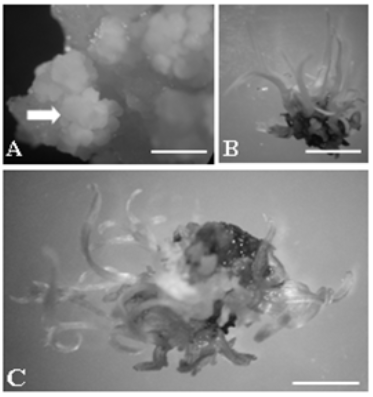Plant regeneration of sugarcane cv. RB931003 and RB98710 from somatic embryos and acclimatization
DOI:
https://doi.org/10.20873/jbb.uft.cemaf.v2n3.dibaxPalabras clave:
Saccharum spp., 6-benzylaminopurine, ussue culture, somatic embryogenesisResumen
The aim of this study was to establish a protocol for regeneration and acclimatization of sugarcane (RB931003 and RB98710) cultivars from somatic embryos. For the cultivar RB931003, the concentration of 0.25 mg L-1 BAP was efficient and provided the shoot induction in 80% of embryogenic masses. For the cultivar RB98710, the highest percentage of shoot induction was observed in 0 and 0.25 mg L-1 BAP, which promoted 70% and 75% of shoots from embryogenic masses, respectively. The MS medium without growth regulators proved to be appropriate for elongation and rooting of shoots and the use of substrate composed by vermiculite and MS salts was effective in the acclimatization of plants for both cultivars analyzed.
Citas
Ali, A.; Naz, S.; Siddiqui, F. A.; Iqbal, J. (2008), Rapid clonal multiplication of sugarcane (Saccharum officinarum) through callogenesis and organogenesis. Pakistan Journal of Botany, 40, 123-38.
Alves, S. A. O.; Lemos, O. F. de; Santos Filho, B. G.; Silva, A. L. L. da. (2011), In vitro embryo rescue of interspecific hybrids of oil palm (Elaeis oleifera x Elaeis guineensis). Journal of Biotechnology and Biodiversity, 2, 1-6.
Los Blanco, M. A.; Nieves, N.; Sánchez, M.; Borroto, C. G.; Castillo, R.; González, J. L.; Escalona, M.; Báez, E.; Hernández, Z. (1997), Protein changes associated with plant regeneration in embryogenic calli of sugarcane (Saccharum sp.). Plant cell, Tissue and Organ Culture, 51, 153-58.
Brisibe, E. A.; Miyake, H.; Tanigushi, T.; Maeda, E. (1994), Regulation of somatic embryogenesis in long-terms callus cultures of sugarcane (Saccharum officinarum L.). New Phytologist, 126, 301-7.
CONAB, COMPANHIA NACIONAL DE ABASTECIMENTO (2007) Central de informações agropecuárias: safras – cana. http://www.conab.gov.br. Cited 15 jan 2011.
Falco, M. C.; Mendes, B. M. J.; Beatriz, M.; Tulmann-Neto, A.; Appezzato-Da-Glória, B. (1996), Histological characterization of in vitro regeneration of Saccharum sp. Revista Brasileira de Fisiologia Vegetal, 8, 93-7.
Fitch, M. M. M.; Moore, P. H. (1990), Comparison of 2,4-D and picloram for selection of long-term totipotent green callus of sugarcane. Plant Cell, Tissue and Organ Culture, 20, 157-63.
Franklin, G.; Arvinth, S.; Sheeba, C. J.; Kanchana, M.; Subramonian, N. (2006), Auxin pretreatment promotes regeneration of sugarcane (Saccharum spp. Hybrids) midrib segment explants. Plant Growth Regulation, 50, 111-19.
Hendre, R. R.; Gupta, V. S.; Mascarenhas, A. F.; Ranjekar, P. K. (1993) Differences in repeated DNA sequences between callus and shoot tissue of sugarcane (Saccharum officinarum L.). Indian Journal of Biochemistry and Biophysics, 23, 80- 86.
Ho, J.; Vasil, I. K. (1983), Somatic embryogenesis in sugarcane (Saccharum officinarum): The morphology and physiology of callus formation and the ontogeny somatic embryos. Protoplasma, 118, 169-80.
Lamb, C. R. C.; Milach, S. C. K.; Pasquali, G.; Barro, R. S. (2001) Regeneração de plantas a partir de segmentos de base de folhas de aveia.

Descargas
Publicado
Cómo citar
Número
Sección
Licencia
Copyright (c) 2024 - Journal of Biotechnology and Biodiversity

Esta obra está bajo una Licencia Creative Commons Atribución 4.0 Internacional.
Los autores que publican en esta revista aceptan los siguientes términos:
Los autores mantienen los derechos autorales y conceden a la revista el derecho de primera publicación, con el trabajo simultáneamente licenciado bajo la LicenciaCreative Commons Attribution (CC BY 4.0 en el link http://creativecommons.org/licenses/by/4.0/) que permite compartir el trabajo con reconocimiento de la autoría y publicación inicial en esta revista.
Los autores tienen autorización para asumir contratos adicionales separadamente, para distribución no exclusiva de la versión del trabajo publicado en esta revista (ej.: publicar en repositorio institucional o como capítulo de libro), con reconocimiento de autoría y publicación inicial en esta revista.
A los autores se les permite, y son estimulados, a publicar y distribuir su trabajo online (ej.: en repositorios institucionales o en su página personal) en cualquier punto antes o durante el proceso editorial, ya que esto puede generar alteraciones productivas, bien como aumentar el impacto y la citación del trabajo publicado (disponible en El Efecto del Acceso Libre en el link http://opcit.eprints.org/oacitation-biblio.html).


